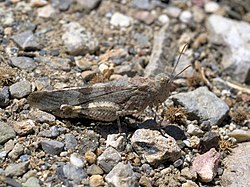| Oedipoda caerulescens | |
|---|---|
 | |
| Male Nature Park of Alvão, Portugal | |
 | |
| Scientific classification | |
| Kingdom: | Animalia |
| Phylum: | Arthropoda |
| Class: | Insecta |
| Order: | Orthoptera |
| Suborder: | Caelifera |
| Family: | Acrididae |
| Subfamily: | Oedipodinae |
| Tribe: | Oedipodini |
| Genus: | Oedipoda |
| Species: | O. caerulescens |
| Binomial name | |
| Oedipoda caerulescens | |
| Synonyms | |
Oedipoda fasciata Fischer, 1853 | |

The blue-winged grasshopper, Oedipoda caerulescens, [1] is a grasshopper in the genus Oedipoda .